Category Archive for India
Elefantastic, an ethical elephant sanctuary in Jaipur, India! Review & discussion of elephants attractions, rides.

Hello, my gentle giant!
Let me introduce you to a compassionate elephant sanctuary in Jaipur, India — Elefantastic. I saw firsthand how the caretakers treat elephants like family, and dedicate their lives to raising awareness about conservation and ethics.
Elephant tourism is a contentious subject, as these sensitive creatures are too often mistreated. Let’s have a open conversation in this post, and I welcome your thoughts as always.

In my view, travelers should educate themselves about animal attractions, and refuse to support those that are cruel. Before my trip, I did extensive research about elephant experiences in India. Many locations offer rides (particularly at Jaipur’s Amber Fort), but these unequivocally cause the elephants to suffer (carrying loads of tourists in a painful saddle, getting prodded with hooks and kept in chains, not having adequate care and rest).
Then, I read about Elefantastic — a Jaipur sanctuary that makes rescuing elephants its mission. I browsed through reviews and blog posts, and saw that the response was universally positive.
Here, guests get to interact with these intelligent creatures in ethical ways, including feeding and washing them, and decorating them with nontoxic chalks (more on that later, as well as the meaning of Hindu swastikas!)

Yukiro and I were traveling through India with the highest-rated travel company, Janu Private Tours, and they’ve always given us fair and honest advice. Mr Janu has brought travelers to Elefantastic since it opened in 2012, and assured us that the sanctuary met the highest standards.
When we arrived, we were greeted by Elefantastic’s owner Rahul (Anil Choudhary, above). He spoke passionately about his mission: rescuing elephants, taking responsibility towards their welfare, educating guests through positive interaction.

Rahul assigned us to one of the female elephants, and we were with her for the entire half-day. He showed us how she liked to be touched: on the trunk, at the cheeks, under the big floppy ears. We could even wrap our arms around her trunk and give her a hug! She responded happily, with bright eyes and a flip of the ears.
Have you ever been up close with an elephant? It’s incredible… these are the largest land animals in Asia, yet they’re so gentle and intelligent. We felt we could put our full trust in her, and it was clear that she was enjoying the human attention.
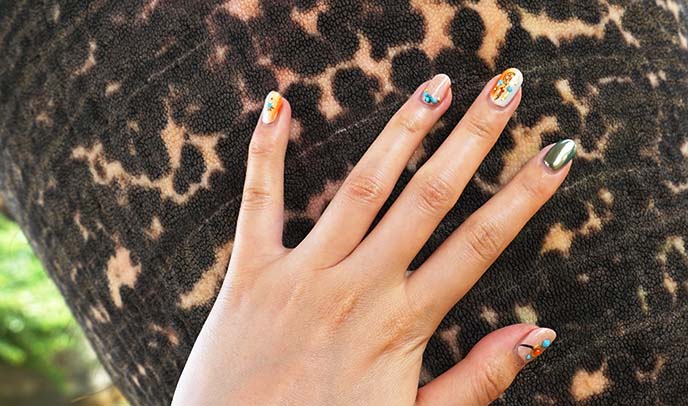
Close-up on her beautiful grey skin, which has some mottled patches on the nose bridge. (All Indian elephants have different markings, and distinct personalities once you get to spend time with them).
My India-themed nail art is by Glam Nail Studio; they decorated my gradient gel nails with small gems and a chrome polish finish.

Our elephant’s “mahout,” or keeper, never left her side. In India, mahouts typically begin their profession as boys, and are assigned to an elephant for life.
At Elefantastic, we saw that the elephants live in their own individual houses, which they share with their mahout and his family. The sanctuary is on a huge plot of land, and the creatures have plenty of room to roam freely (they are never tied up).
Our mahout tied together palm fronds and stems, and showed us how to feed our elephant. We placed the bundle in the nostril area of her trunk, and gave the verbal command “Leht.” She grabbed the food and dexterously twisted it up to her mouth!

Fun facts: Indian elephants spend 14-19 hours a day feeding, and consume several hundred pounds of vegetation daily. They are vegetarians and mainly eat leaves, tree bark, roots and stems.
Our elephant was clearly well-maintained; she was calm and radiated happiness. Aren’t her brown eyes lovely? (Eye contact is important for making the elephants feel secure, so you can’t wear sunglasses during this activity. I’m wearing tinted prescription glasses.)
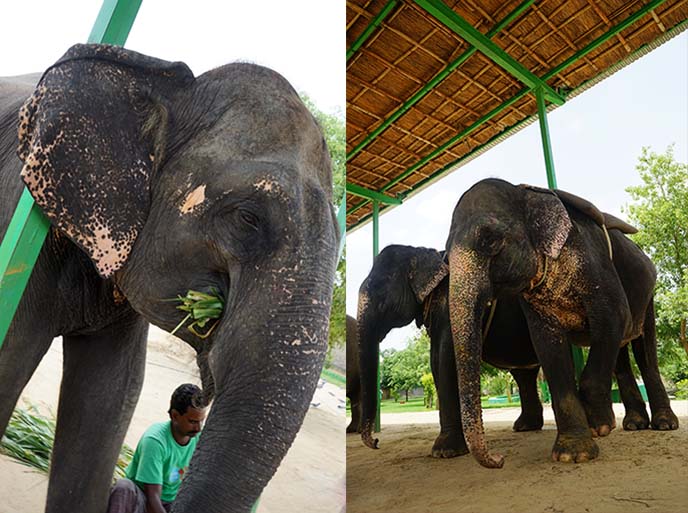
I loved seeing the close bond between the mahouts and their life-long partners. These caretakers guide them with Sinhalese verbal commands such as “stay” or “walk forward.” They never use chains, hooks, poles or any instruments to force the elephants. They’ll sometimes gently tug the elephant’s ears with their hands to steer her, but this doesn’t cause pain.
As you can see, Elefantastic’s residents always have shade from the elements, and the grounds are meticulously maintained.

Once our elephant had her meal, it was time to give her a makeover! In India, elephants are traditionally painted in rainbow colors for festivals and special occasions. Unfortunately, many of these paints are harsh and contain lead.
Elefantastic provided us with a palette of non-toxic, organic chalks that cause no harm to their bodies (I got some on my hand, and it washed right off with water). Since elephants don’t sweat and only have pores between their toes, this doesn’t clog up their skin.
Of course, we dressed her in Goth and punk symbols! Pentagram, 666, A for anarchy, a wonky Leviathan cross. But what’s the deal with the swastika?

If you spend any time in India, you’ll come across swastikas, especially on the front of doors and gates.
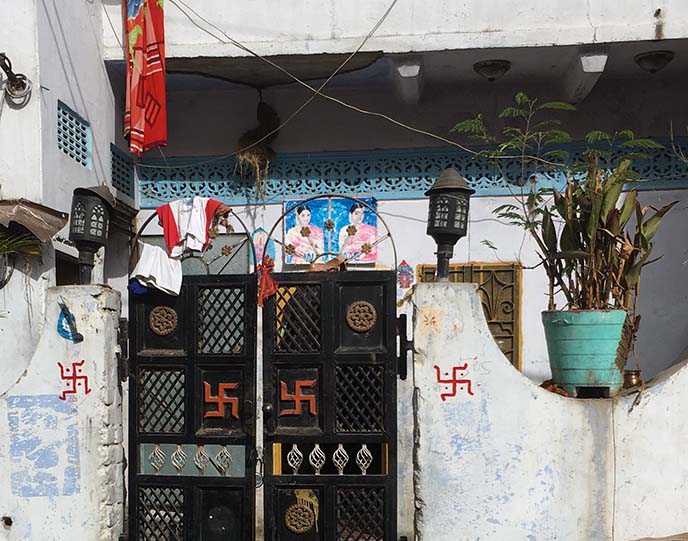
While Westerners primarily associate the swastika with Nazi Germany, it is in fact an ancient Sanskrit symbol that translates to “marker of goodness.” In other words, this has been an auspicious Hindu sign for thousands of years, long before the terrible events of World War II.

Our neon elephant looks like she’s ready for a rave! We decorated her side with lucky “swastika rangoli,” which have dots between each of the four arms.
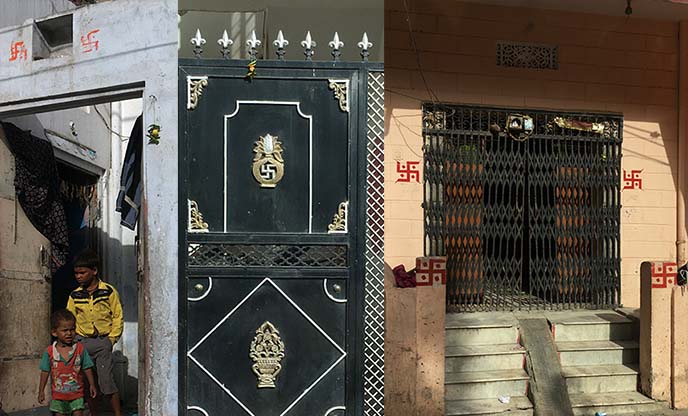
Many Hindus paint swastikas on doorways and home entrances, to invite in prosperity and good fortune. (I took these images in a residential area of Jaipur.)

I think our Gothic elephant painting project turned out rather well! She’s one of us now.
(My black sun hat is by Lack of Color; more of their designs are below.)
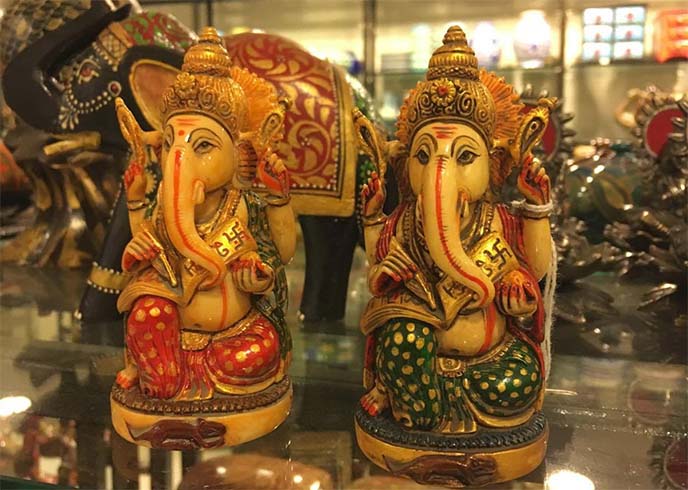
In Hinduism, the clockwise swastik is a representation of Lord Vishnu and the sun god Surya. I also found it on the sash of Ganesha, the elephant god.
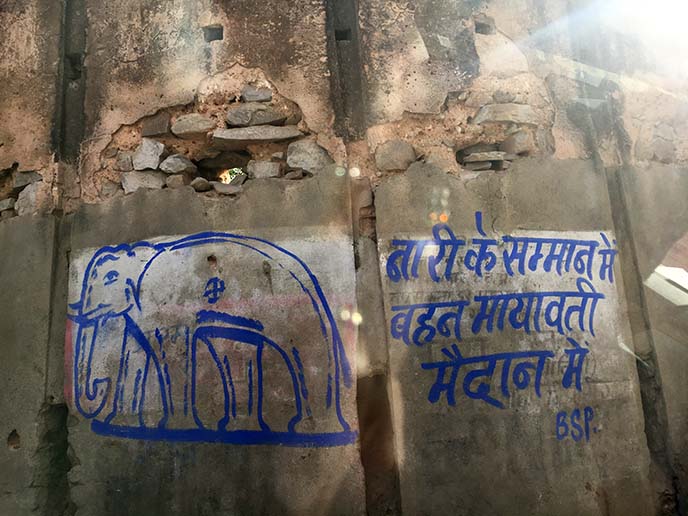
Less commonly, you’ll see the reverse / counterclockwise version, or sauvastika. It is associated with the goddess Kali, magic and nighttime.
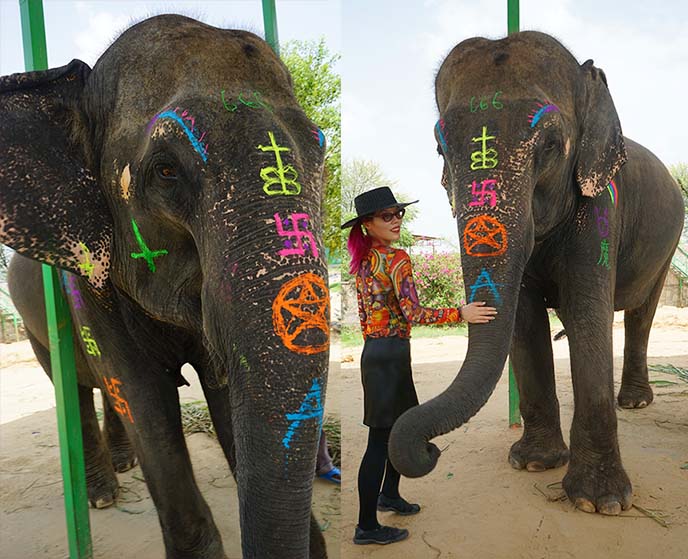
Regardless of how you decorate your elephant, it’s fun to take part in the cultural ritual. Our new friend leaned in and loved the strokes and attention.

We added some devilish kawaii to this flank. Can you tell we’re having fun?

Now, it’s time for a bath! Our mahout walked our elephant over to a grassy field, and we hosed her down with water. (The safe chalks came right off.)

We put some water into a bowl, and our elephant sucked it up like a straw. Then, she swung her trunk around and sprayed herself to cool off!
Water for elephants is a must: they can drink 200 liters a day. The staff kept us hydrated too, offering us unlimited chilled bottles of water, and masala chai.
I posted some video clips of the Elefantastic experience above and here. Watch us hand-feed our friend and bathe her, along with other footage of traveling in India.
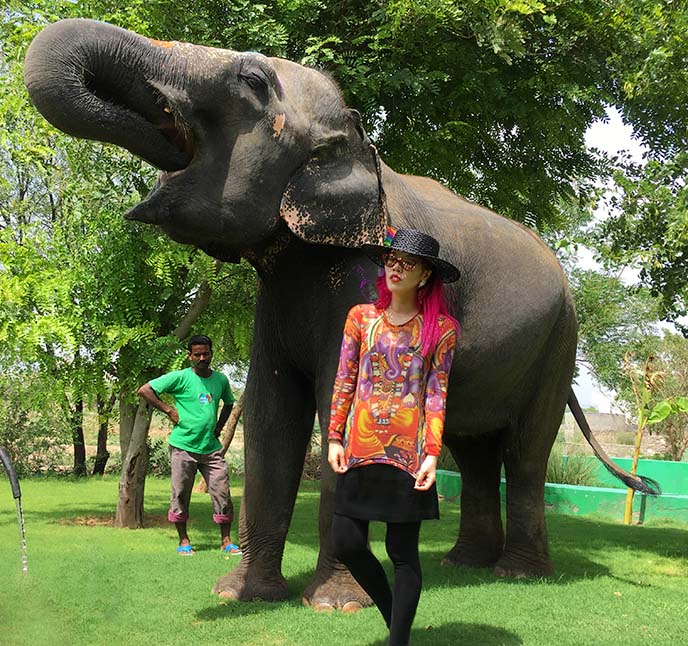
Out of the three individuals above, who has the most fabulous pose? I’m guessing you would say the elephant!
(My glasses frames are by Oliver Goldsmith, and my sunhat is by Lack of Color. Shop with a click:)

Close-up on my vintage Vivienne Tam colorful top, which fit the theme of the day perfectly.
One of the most beloved Hindu gods is the elephant-headed Ganesh. Some say that Lord Shiva beheaded him, and replaced his head with that of an elephant. Lord Ganesha / Ganapati is known as a wise, playful scholar who removes obstacles, and is the patron of the arts and sciences.

Once you get to know a real-life Ganesha, you can see where these characteristics come from. Yukiro and I were in awe of our elephant’s sensitivity and intelligence, which came through in the way she connected with us and her environment.
These mammals are known for their wide range of complex social behaviors: grief, memory, altruism, cooperation, using tools… In many ways, they leave us in the dust.

She is a 28-year-old Indian elephant, a sub-species with smaller ears than her African cousin. About half of female Asian elephants have short tusks, or tushes, which you can see when she opens her mouth for a drink.
Since 1986, India’s elephants have been listed as endangered, as they have suffered significant population decline. Poaching and the loss of natural habitats are mainly to blame. It’s more important than ever to donate and support conservation efforts like Elefantastic’s, to stop them from becoming extinct.

Elefantastic listens to its guests, and is always striving to do their best for the sake of their rescued elephants. When we visited in mid July, the policy was that elephants could only be ridden in an ethical way: once every two days for 45 minutes max, and without a saddle that causes discomfort. Guests could sit “bareback,” on a soft cushion that is tied and positioned in a way that does not hurt.
However, as of late July 2017, Elefantastic has come to the decision that they will no longer allow elephant rides, to raise awareness toward animal welfare.

Yukiro and I were therefore some of the last guests to get on top an elephant. We chose to ride for only 15 minutes (we climbed up here from stepping off a staircase). Our mahout led her through the spacious grounds, while we hung on tight and petted her bristly forehead!

While we felt that this method did not stress the elephants, we agree with Elefantastic’s decision to stop all rides. From now on, guests can walk alongside their new friend, and take her for a leisurely stroll on the property.

We can honestly tell you that elephants are treated with the utmost respect at Elefantastic. We saw them living in un-tethered natural conditions, and connecting with their gentle mahout keepers.

What a joy to be in the presence of these powerful creatures. I encourage you to support this fantastic animal sanctuary, and volunteer with the elephants for yourself.
To make a booking: visit the Elefantastic website and email Rahul (hello@elefantastic.in) to secure your reservation. They offer hotel pick-ups and drop-offs, and you can either start in the morning or afternoon for half a day of activities. A delicious vegetarian lunch is included at Rahul’s mother’s house — the simple meal is made with love, and was one of the best I had in India!
(Elefantastic address: 90 Chandra Mahal Colony, Delhi Road, Amer, Jaipur 302002, India)

You can find out more about Elefantastic here. Namaste to Rahul for his admirable work to help elephants, and to Janu Private Tours for making this experience possible. Stay tuned for more stories from India — next, we’ll go on an insider tour of Jaipur with Mr Janu.
What are your thoughts on elephant travel attractions, and sanctuaries like this one? You’re welcome to leave any thoughts or questions in the comments.
SHARE & COMMENT
New Delhi, India with Janu Private Tours! Review of guide, driver tour: Jantar Mantar, Jama Masjid, Humayan’s Tomb.
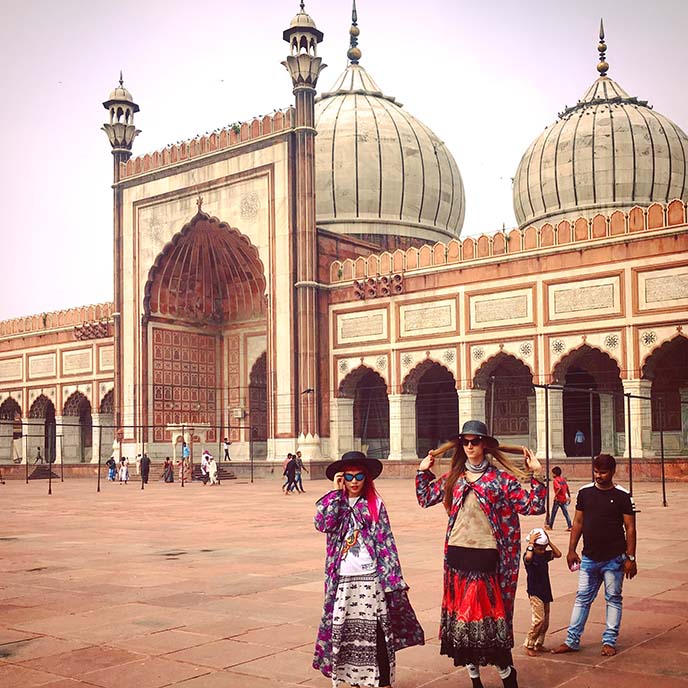
“India Waale!” After year of talking and planning, Yukiro and I finally made it to India!
Even though we’re experienced travelers, I confess I had some trepidation about coming here. I’ve heard that India can be a challenging destination, with abundant culture-shock. But it turned out these fears were unfounded, as we were in the best possible hands with Janu Private Tours.
I’m so glad we went with this highly-rated tour company, as they gave us the royal treatment throughout Northern India. The kind owner, Mr Janu, paired us with expert guides and drivers, booked us lovely hotels, and took us to several cities in a spacious and fully-stocked car.

Janu Private Tours has over 500 positive TripAdvisor reviews for a reason: his clients trust him, and he goes above and beyond to make them feel at home. Mr Janu encourages guests to come with a “clear mind and open heart — welcome to India.” And that’s exactly what we did: dive in, go with the flow, and experience the fascinating wonders of this country without judgement.
It makes sense to tell this tale chronologically, so read on for our travel preparations (how to get a visa, what to wear), and first impressions of New Delhi!
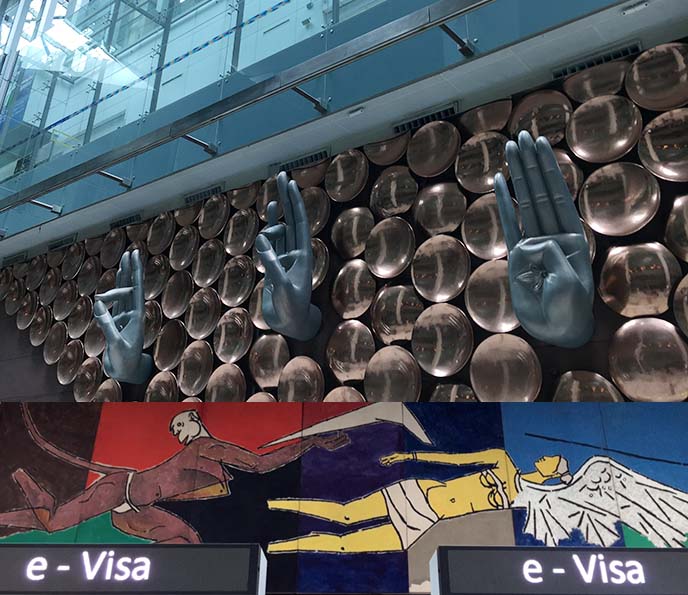
Let’s start with some prep talk about vaccinations and visas.
– Vaccines: A trip to India requires a bit more preparation than usual. Yukiro and I went by the CDC recommendations for travellers: we made sure our basic vaccinations were up to date, and got shots for typhoid. I also took Dukoral, an oral vaccine that helps prevent stomach sickness (you have to take the first of two doses at least 2 weeks before you depart).
– Tourist visa for India: Allow yourself plenty of time to get the tourist e-Visa, which you can now submit online. Yukiro and I filled out the visa carefully, and got it approved without any questions or hold-ups within two days, but it takes longer for others. Make sure you use the official goverment visa site, as there are fake ones.
– The Indian e-visa does ask some weird questions (are you transgender, what’s your religion, do you have visible marks, have you been to Pakistan, are you illiterate?) We made sure all our contact info was correct, and that the photo and passport scans were clear (with an addendum since I didn’t have room to list all the countries I’ve visited in the past 10 years, in the section provided).
– Don’t leave anything blank. For religion, I put “Other: N/A”. (I would caution against putting Atheist, Satanist, Agnostic Pagan, Wicca or things like that… best not to raise any eyebrows!)
– Make sure you jot down the temporary ID number and payment number, so you can save and continue filling out the form if the page fails.
– Payment problems: many including myself had trouble loading the final page (SBI payment – the server fails). Instead, for the final stage, go onto your smartphone and use 3G / 4G data (not wifi). Enter the “payment reference number” to get back to that page, and then pay using Paypal (for me, credit card also resulted in error).
– You’ll get your approved visa by email; be sure to print it out. Once you arrive at Indira Gandhi airport (which is lovely – see the mudra hand gestures sculptures above), head to the e-Visa line and you’re all good!

I highly recommend that you do a private tour with a driver, especially if you have limited time. Mr Janu was waiting for us at the airport arrivals, and helped us cut through the crowds to reach the car and head straight to the hotel. We never had to deal with touts, haggle with taxis or stress over scams and directions — all of which are aplenty in India.
Janu Private Tours has tons of connections throughout the country, and knows the best hotels for your budget and needs. Mr Janu checked us into The Park hotel and it was exactly what we wanted: a 4-star hotel in the heart of the city, with decor that reminded me of a Japanese host club!
– What to wear in India? In big cities like Delhi, anything goes, but it’s best to wear modest cover-up clothing in smaller and rural areas. I suggest packing light, long skirts such as my elephant maxi skirt. Bring close-toed shoes and sandals with a bit of lift, as the streets can be dirty (I threw out my shoes after the trip).
– Outfit details: I’m wearing a 1991 New York Shiva shirt, arm covers, sunglasses by Clearly, and a black sun hat by Lack of Color. Most importantly, I’m covered in DEET-containing mosquito spray, the only thing that truly repels them. Bens 100 mosquito spray is the strongest one out there, and I didn’t get a single bug bite thanks to it.
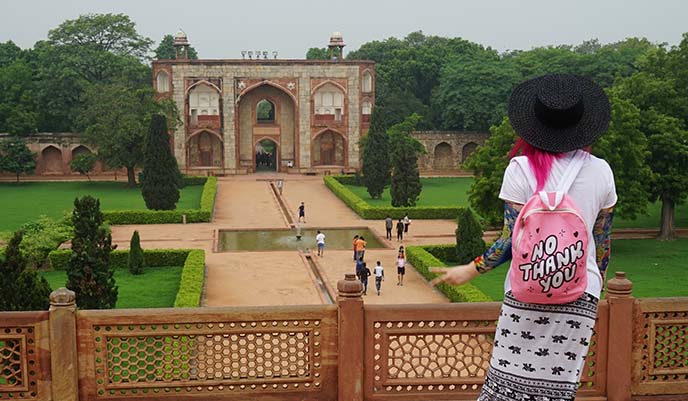
India is a safe country as long as you stay aware of your belongings, and use common sense. I wanted a secure bag to hold my possessions, and found the perfect one: this pink backpack by Print All Over Me, designed by Stella Rose (who released an adorable collection with them!)
A lot of Indian street vendors and beggars approached us, and locals often asked to take photos… so it was fun to point to the “No Thank You” and politely decline!

In our week together, we got to know Mr Janu (or Shabbir Khan) as a friend. The story behind Janu Private Tours is an inspirational one: as a teenager, Janu became a tuk tuk driver to support his family. He hardly knew English, had no advanced schooling, had never left his hometown of Jaipur…
However, he had drive and vision: Janu decorated his tuk-tuk to the nines, and built up trust with locals. He became known for showing tourists around Jaipur with passion. Gradually, he built up clients and expanded his business into car-guided tours in Rajasthan, then all of India.

It’s amazing how Janu went from manning a tuk tuk driver (the yellow and green auto-rickshaws above) to becoming a successful business owner who is well-travelled, fluent in English, and constantly growing his endeavors. He now has 30 staff members, and has worked on productions for BBC, the Best Exotic Marigold Hotel movie, music videos for Romanian pop star Loredana, and more.
I’ll show you his latest venture, a hotel, and more in the next posts — but as you can gleam, Janu is a remarkable person and we were happy to get to know him.

We weren’t sure which landmarks to see in New Delhi, and put our trust in Janu. He took us to Jama Masjid mosque, and as you can tell, we loved everything about it.
At the entrance, women are provided with robes to wear over their clothes. You have to remove your shoes, but can wear socks or purchase slippers for 100 rupees. Entry is free but there’s a 200 rupee photography charge (generally, attractions in India have entry fees of 200-500 rupees, or $3-7.)

Jama Masjid is one of largest mosques in India, and an architectural beauty. It was built by by Shah Jahan in the mid 17th century (this is the Mughal emperor who also also built the Taj Mahal, which we visited later on.)
Muslims from around the country come here to worship. How beautiful are the scalloped arches made from red sandstone and white marble, ornamented to look like a prayer mat.

Oh dear, everyone wants to take a photo! The scene above may look intense, but these are merely travelers from around India who are curious about foreigners. Everyone was respectful, and our guide helped us gently walk away after a few snaps. (We learned that it’s best to politely decline, since if one person is allowed a photo, then everyone else wants in — and you’ll be making cute poses for half an hour).

Loving the warm, subtle design and symmetry of Jama Masjid.
My friends and I try to travel to destinations in the off-season, to avoid crowds. We went in early July, and got lucky — the high heat had died down, but the monsoon rains had not yet fallen. If we went during peak season (October to March), the courtyard would have been teeming with tourists.

The mosque is right next to Chawri Bazar, the chaotic marketplace of Old Delhi. It’s a colorful free-for-all of narrow streets, laborers, fruit stands, beggars, monkeys climbing electrical lines, you get the picture.
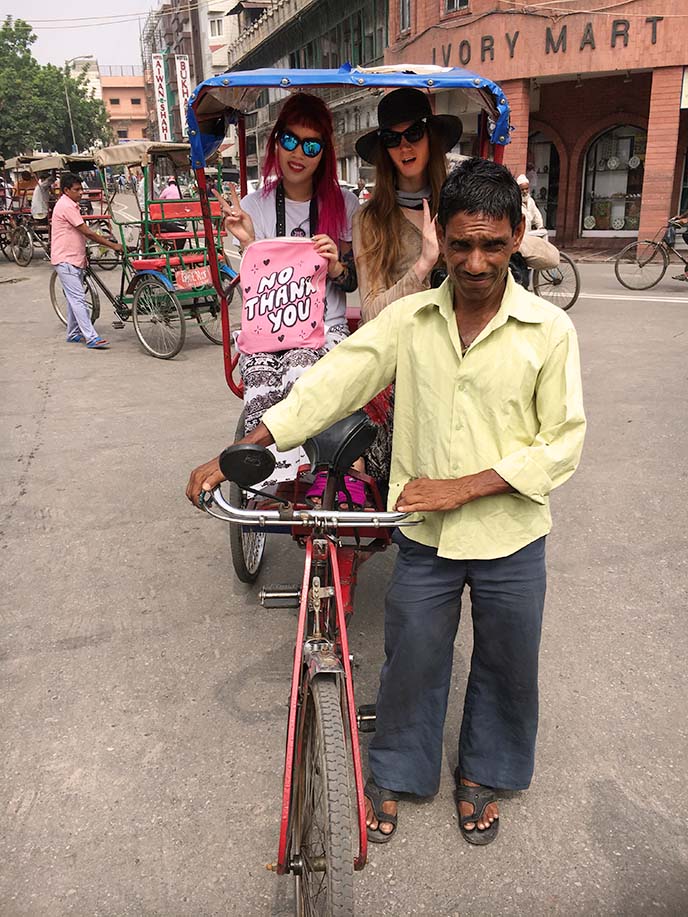
We wanted to take in Old Delhi, but it would have been too intense to walk around on our own. Janu Private Tours arranged the perfect solution: a rickshaw ride through the historic district!
Yukiro and I squeezed into the back of the three-wheeled bike, and held on for dear life as our driver peddled through the half-mile-long bazaar.
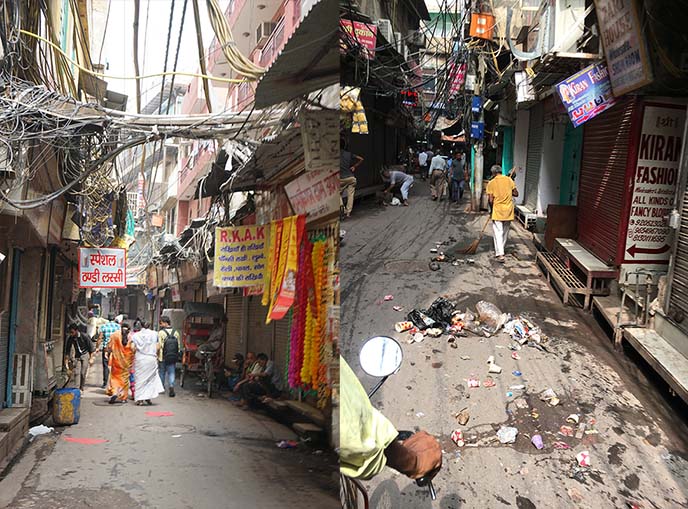
Our rickshaw raced down the alleyway. I turned to Yukiro and exclaimed, “This is better than the Indiana Jones amusement park ride!”
The driver was a pro, yet it felt like danger was at every turn. Sparks from low-hanging electric wires, puddles of water that I hoped wasn’t sewage, people in the streets, piles of garbage, packs of street dogs…
I’m not going to sugarcoat the experience of India: you’ll see dirt, poverty, difficult sights. But if you come in with a open mind and go with the flow, then this might be the most transformative place you’ll ever visit.

Every moment was a learning experience. So much to take in; overpowering sights and sounds. So many questions about the unique and sometimes conflicting culture, which Janu and his guides helped us to understand.

Since we had a car/driver, we were able to see many sights, and cool off in between under the air conditioning (Janu’s cars come with a chest full of cold water, sodas and snacks for guests).
Onward to Humayan’s Tomb, resting place of the 16th century Mughal emperor. The mausoleum was commissioned by his first wife and chief consort, Empress Bega Begum.

Our guide walked us through the arches, and explained how India’s Mughals are descended from the Mongol empire. These rulers were all Muslim, and India came to a golden age of architecture, culture and science during this era (especially the reign of Shah Jahan in the 17th century).

Enter the portal. I’m wearing a 1991NewYork t-shirt with an image of Lord Shiva.
Persian architect Mirak Mirza Ghiyas ornamented the the tomb with symbolic carvings, marble lattice screens, and geometric motifs like eight-pointed stars.

“No Thank You!” Living for my cheeky Print All Over Me x Stella Rose backpack. I’m a huge fan of PAOM, which carries thousands of exclusive designs by artists. On their site, anyone can custom-print artwork onto a variety of garments for both men and women. Every item is produced sustainably, and the quality is top notch (I’ll be showing you more of their designs soon).
I’m standing in the Char Bagh, or “four gardens” that lead to the tomb of Humayan. The Persian-style quadrilateral layout is immense, with symmetrical water channels and hedges.

The precisely layered shapes draw the eye, and the cut-out windows bring in glowing light.
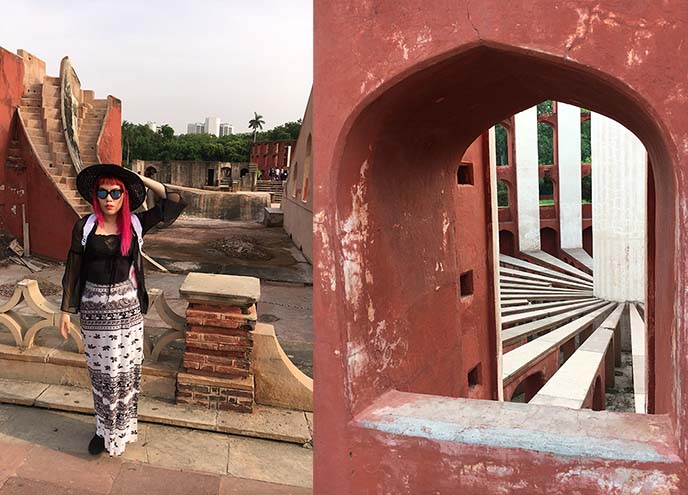
Perhaps my favorite attraction in New Delhi was Jantar Mantar, a collection of thirteen giant, bizarre astronomy instruments! In the 18th century, Maharaja Jai Singh II constructed the observatory to chart the movements of celestial bodies and make astrological measurements.

If I came across these structures without knowing what they were, I’d assume they were built by aliens. In fact, they’re instruments based on mathematical principles, and determine various measures of the sun, moon, planets and time.
Misra Yantra (the strange curving staircase above) is a tool to calculate the shortest and longest days of the year. It can also find the exact moment of noon in various cities and locations, and the results are amazingly accurate.

Is that the Colosseum of Delhi? Nope, it’s Rama Yantra, which measures the altitude of objects and the azimuth (position of a celestial object such as a star, relative to a point).

If you look inside the windows, you’ll see the weird sight on the right. The shadow falling on the scale makes the calculus (something to do with the angle and projection onto the horizon — I don’t quite get it).
On the left, this towering structure looks like something out of Burning Man. It’s the Central Triangle of Large Samrat Yantra. This “supreme instrument” serves as an equal hour sundial, but also can precisely measure declination and other coordinates of heavenly bodies.

“And she’s buying a stairway to heaven…”
The epic triangle is 70 feet high, with a hypotenuse parallel to the Earth’s axis and pointing to the North Pole. It’s flanked by two quadrants with graduations that indicate hours, minutes, and seconds.

New Delhi’s Jantar Mantar is a trippy place that got my imagination flowing. I didn’t know the Indian astronomers had such advanced instruments, and enjoyed learning about Jyotish (the traditional Hindu system of astrology).
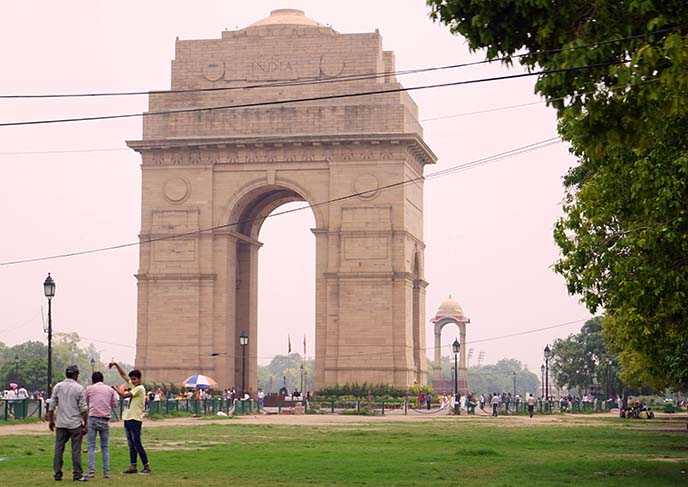
Thanks to Mr Janu’s expert arrangements, we were able to see all of the above in single day. Delhi is a spread-out capital, and this would have been impossible to accomplish on our own.
India is one of the world’s oldest civilizations, and driving through Old and New Delhi, you come across the many layers of history. We passed by India Gate, memorial to the 82,000 soldiers of the Indian Army who died in World War I.
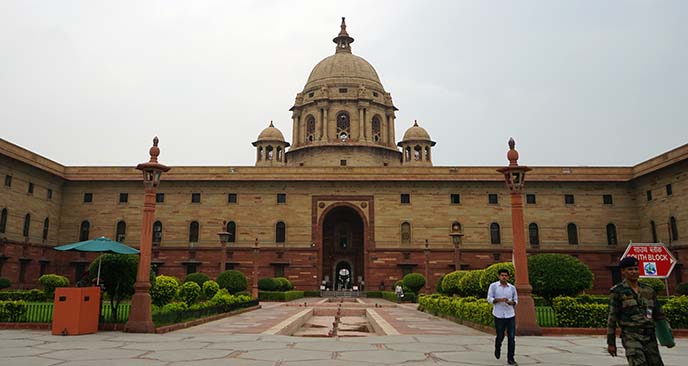
We also drove by Sansad Bhawan or Parliament House, which dates back to 1927. This was during the time of the Raj, or British rule of India beween 1858 and 1947 (when Gandhi’s nonviolent movement led to Indian independence).
India has over 700 dialects, but English and Hindi are the official languages, and there remain vestiges of British influence everywhere.
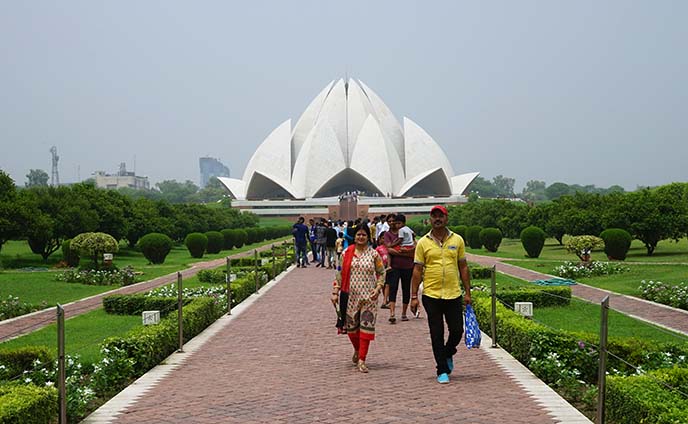
The aliens have landed elsewhere in Delhi.
It’s not a spaceship, it’s the Lotus Temple — a Bahá’í House of Worship completed in 1986. Design magazines praised the minimalist organic design and spaceship feel.
Baha’i is a fascinating and inclusive faith that originated in the Middle East. The flower-like temple is open to everybody, regardless of religion, race, gender or any background.

India, you’re amazing. Even though I’ve been to over 60 countries, there was so much I learned and experienced for the first time.

It’s a country of contrasts, with elements that Westerners will likely find odd (like holy cows and animals in the streets).
We’ve wanted to see India for a long time, and are glad we “did it right” by traveling with Janu Private Tours. They took care of the logistics of getting around, gave us valuable guidance and helped us dive into the heart of the culture.

Namaste Janu Private Tours for the warm welcome to India! Can you believe we did all of the above in only one day?
I have lots of India stories to share with you: an elephant sanctuary and palaces in Jaipur, Agra’s Taj Mahal, Varanasi on the river Ganga… keep your eyes peeled.
PS: if you have any questions about traveling to India, packing, prep or anything at all, leave me a comment and I’ll help you out as best as I can!

 LA CARMINA
LA CARMINA






